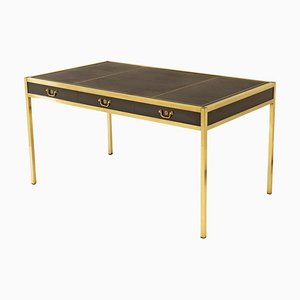
Paris-based design firm Maison Jansen was one of the most well-known and influential interior decorating houses of the 20th century, patronized by royalty, socialites, leaders of nations, and other luminaries of elite society. It was also one of the first truly global design firms.
Founded in 1880 by Dutch designer Jean-Henri Jansen (1854-1928), Maison Jansen originally sourced existing antiques or contracted outside cabinetmakers to produce furniture when producing custom interiors for clients. By the 1890s, however, the firm began to manufacture furnishings in-house. Soon, Maison Jansen’s luxury, traditional-style pieces earned an international reputation. Their most sought-after pieces reflected the influence of erstwhile designs from the Louis XIV, Louis XVI, Directoire, and Empire eras, as well as objects Jansen encountered during his travels to Japan and Turkey.
By the 1920s, Maison Jansen had offices around the world, including London, New York, Buenos Aires, Havana, Cairo, Prague, Rome, and Rio de Janeiro. During the early 1920s, Stéphane Boudin (1888-1967) joined Jansen as the chief designer and director. His attention to detail, concern for historical accuracy, and ability to create dramatic and memorable spaces brought ever-more work to the firm. Among his many projects, Boudin was responsible the renovations of the White House—including the Red Room, designed in collaboration with Paul Manno—during the administration of John F. Kennedy.
By the 1930s, Maison Jansen’s five-story, Paris atelier employed over 700 highly skilled artisans and would go on to employ many famous designers, including Pierre Delbée (1900-1974), Carlos Ortiz-Cabrera, Francis Chaillou, Serge Robin, Henri Samuel, Claude Mandron, and Arthur Kouwenhoven.
Maison Jansen’s design aesthetic was forward-thinking and counter-cultural, even as the firm came to specialize in high-end reproductions. Among the many styles Maison Jansen’s furniture and interiors drew from are 18th-century Bourbon Court, the Aesthetic Movement, Art Nouveau, Art Moderne, and even midcentury modernism. The firm’s genius lay in mining the past for forms, colors, and materials that were sure to make an impact.
Maison Jansen was commissioned by an array of impressive clients, including William III of the Netherlands, Alfonso XII of Spain, the Duke & Duchess of Windsor, King Leopold II of Belgium, the Shah of Iran, the oil magnate Charles Bierer Wrightsman, Leed’s Castle, Hotel Parr in Vienna, the German Reichsbank, the Rockefellers, Bartolomé March, Coco Chanel, Elsie de Wolfe, and the Kennedys, among many others.
In 1989, sixty years after the death of its founder, Maison Jansen closed its doors. Today, Maison Jansen’s designs are highly sought-after by collectors, fetching high prices at auction that range between $5,000 and $20,000—though it is not uncommon to see even higher prices. The most valuable and collectible examples of Maison Jansen furniture are 18th-century antiques that were appropriated and re-upholstered by Maison Jansen in the late-19th century. To date, the record for highest priced Maison Jansen piece was set at Christie’s in London in 2005, when a suite of Louis XVI parcel-gilt seat-furniture—originally designed by Mathieu Bauve in 1775 and re-upholstered by Pierre Delbée of Maison Jansen—realized £336,400.
For more insight into Jansen's extensive body of work, check out our story, written by Jansen specialist, James Archer Abbott.

